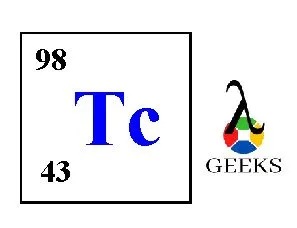Technetium is an element present in the periodic table. Let us discuss the chemical properties of the technetium elements.
Technetium metal is the first artificial or man-made element or metal. It is a synthetic radioactive element and its isotopes are used in various fields. It is a good conductor of electricity.
Let us discuss the atomic weight of technetium, its atomic number, symbol, period, group, and many other related facts in this article.
Technetium symbol
The notation of an element or atom is the symbol of that element or atom. Let us see the atomic symbol of Technetium.
The atomic symbol of the Technetium element is ‘Tc’.
Technetium group in the periodic table
The columns drawn vertically in the periodic table are called groups. Let us see in which group the Technetium element is placed.
Technetium is present in the 7th group of the periodic table. 7th group is also represented as group VIIB.
Technetium period in the periodic table
The rows drawn horizontally in the periodic table are called periods. Let us see in which period the Technetium element is placed.
Technetium element is placed in the 5th period of the periodic table.
Technetium block in the periodic table
The block in the periodic table shows the differentiation of groups of elements in the periodic table. Let us discuss in which block the Technetium element resides.
Technetium element resides in the ‘d-block’ of the periodic table.
Technetium atomic number
The number of protons in an atom is the atomic number (Z). It is also known as a nuclear charge. Let us see the atomic number of Technetium.
The atomic number of the Technetium element is 43 i.e. 43 protons are present inside the nucleus of the Technetium element.

Technetium atomic Weight
The usual ratio of atoms present in an element is known as its atomic weight or molecular weight. Let us discuss the atomic weight of Technetium.
Technetium element has an atomic weight of 98 u.
Technetium Electronegativity according to Pauling
The efficiency of an atom to attract the bonding electron pairs of other atoms is called its electronegativity. Let us see what the electronegativity value of technetium is.
The electronegativity value of Technetium is 1.9 as per the Linus Pauling electronegativity scale.
Technetium atomic Density
The number of atoms presents per unit volume of an element is called the atomic density of that element. Let us discuss the atomic density of Technetium.
The atomic density of Technetium is 11.5 g / cm3.
Technetium melting point
The substance gets melts at a specific temperature called its melting point. Let us see the melting point of technetium.
Technetium element has a melting point value of 2157 degree Celsius i.e. 2430 K or 3915 degrees faraday.
Technetium boiling point
Any substance in a liquid state starts to boil at a specific temperature called its boiling point. Let us see the boiling point of the technetium element.
Technetium element has a boiling point value of 4265 degrees Celsius i.e. 4538 K or 7709 degrees faraday.
Technetium Vanderwaals radius
The distance of nuclei of 2 atoms of an element held together by Vander Waals force of attraction is called Vander Waals radius. Let us discuss the Vander Waals radius of Technetium.
The Vander Waals radius of the Techenium element is 205 pm.
Technetium ionic radius
The ionic radius is the distance between the ionic nucleus and its valence shell electrons of the last orbital. Let us see the ionic radius of the technetium ion.
Technetium ion has an ionic radius of 0.69 Å (Armstrong unit).
Technetium isotopes
The atoms of the same element containing an equal number of protons but an unequal number of neutrons are known as isotopes. Let us see how many isotopes technetium has.
Technetium element has about 22 isotopes. Tc-43 is natural technetium element or is considered an isotope. Some of the isotopes of technetium elements are listed and explained below:
| Isotopes of Tc | Characters |
| Technetium – 97 and 99 (97Tc and 99Tc) | First synthesized technetium isotopes |
| Technetium – 97 (97Tc) | The most stable radioactive isotope with a half-life of 4.21 million years of Tc. |
| Technetium – 98 (98Tc) | Isotope with 4.2 million years half-life period of Tc. |
| Technetium – 99 (99Tc) | Isotope with 211 to 100 years half-life period of Tc |
| Technetium – 93 (93Tc) | Isotope with 4.8 hours half-life period of Tc |
| Technetium – 94 (94Tc) | Isotope with 20 hours half-life period of Tc. |
| Technetium – 95 (95Tc) | Isotope with 23.4 hours half-life period of Tc. |
| Technetium – 96 (96Tc) | Isotope with 20 days half-life period of Tc |
Technetium electronic shell
The outer part of an atom around its nucleus in which the electrons get rotated is called the electronic shell or orbit of that atom.
The electronic shell of the Technetium atom is 2, 8, 18, 14, 1.
Technetium energy of first ionisation
The prerequisite energy to eradicate the high-energy electron of a neutral molecule is called the 1st ionization energy. Let us see the 1st I.E. of Technetium.
The first ionization energy of the Technetium atom is 702.13 kJ / mol.
Technetium energy of second ionization
The prerequisite energy to remove the electron from +1 ion (2nd electron after the loss of 1st electron) is called the 2nd ionization energy. Let us see the 2nd I.E. of Technetium.
The energy of the second ionization of the Technetium atom is 1472 kJ / mol.
Technetium energy of third ionisation
The prerequisite energy to remove the electron from +2 ions is called the 3rd ionization energy. Let us see the 3rd I.E. of Technetium.
The third ionization energy of the Technetium atom is 2850 kJ / mol.
Technetium oxidation states
The atom loses or gains its electron to form a bond and has a positive or negative charge called its oxidation state or number. Let us discuss the oxidation state of Technetium.
Technetium atom shows oxidation states of -1, 0, +2, +3, +4, +5, +7 etc.
Technetium electron configurations
The electron distribution in the orbital of an atom around its nucleus is called its electronic configuration. Let us see the electronic configuration of Technetium.
The electronic configuration of Technetium element is 1s2 2s2 2p6 3s2 3p6 3d10 4s2 4p6 4d5 5s2 or [Kr] 4d5 5s2
Technetium CAS number
A registered unique identification number for a chemical assigned by the U. S. Chemical Abstracts Services (CAS) is the CAS number. Let us see the CAS number of technetium.
The CAS number of Technetium is 7440-26-8.
Technetium ChemSpider ID
The ID provided by the Royal Society of Chemistry for each compound is the ChemSpider ID. Let us see the ChemSpider ID of Technetium.
The ChemSpider ID of the technetium element is 22396.
Technetium allotropic forms
Allotropes are the various forms of one element that differ in atomic arrangement and can survive at the same temperature and pressure. Let us see the allotropes of technetium.
β-Technetium is an allotrope of technetium elements which is in a tetragonal shape.
Technetium chemical classification
The elements are classified in the periodic table as per their chemical properties. Let us see in which class technetium gets classified as a chemical element.
The Technetium element is classified as a transition element and comes under d-block elements.
Technetium state at room temperature
The chemical compounds show their state of matter like solid, liquid, or gas to which they belong at room temperature. Let us see the state of technetium at room temperature.
Technetium is a solid metallic element at room temperature.
Is technetium paramagnetic?
Paramagnetic elements are those which contain unpaired electrons and are attracted to the magnetic fields. Let us see whether technetium is paramagnetic or not.
Technetium is slightly paramagnetic in nature as it contains one unpaired electron in its outer shell orbital. It has a magnetic susceptibility value of +270.0×10−6 cm3/mol.
Conclusion
Technetium element has symbol Tc. It has an electronegativity value of 1.4 and atomic number 43. It comes under the 5th period and 7th group of the periodic table. It is solid in element and a transition metal that comes under d-block elements. It has an atomic weight of 98 u and 11.5 g /cm3 density.

Hello everyone, I am Dr. Shruti M Ramteke, I did my Ph.D. in chemistry. I am passionate about writing and like to share my knowledge with others . Feel free to contact me on linkedin